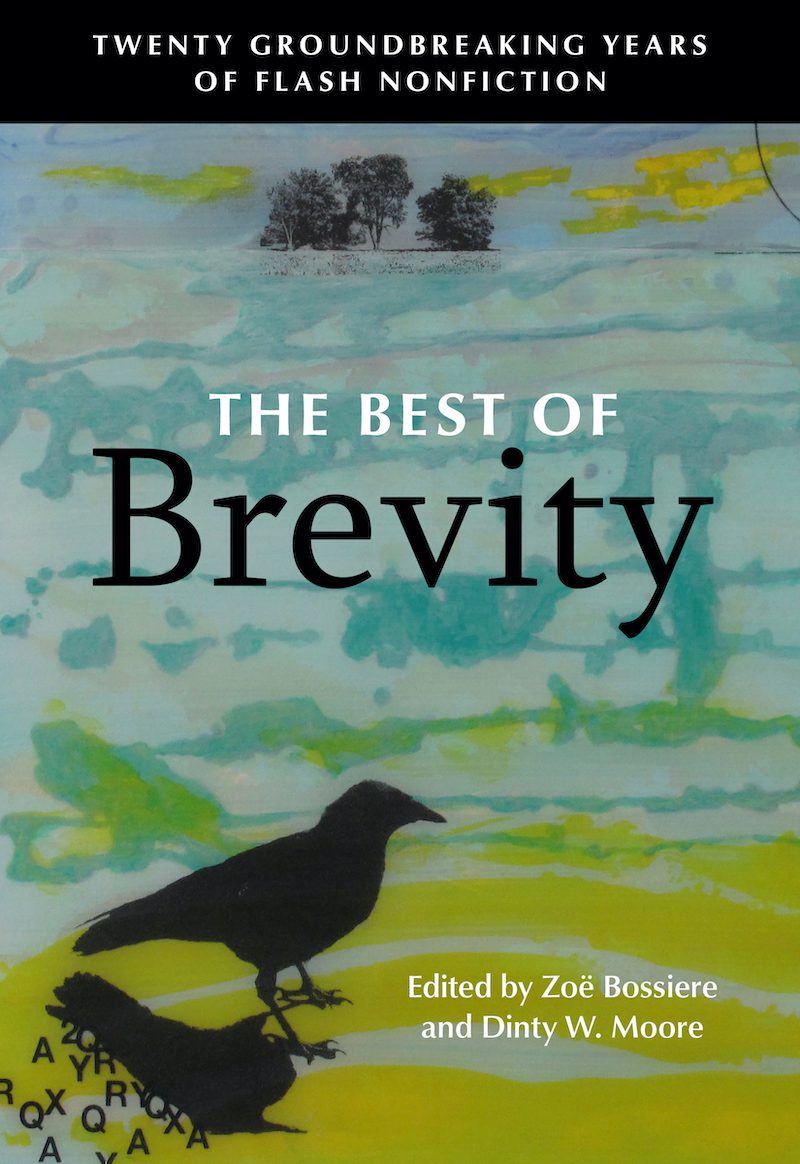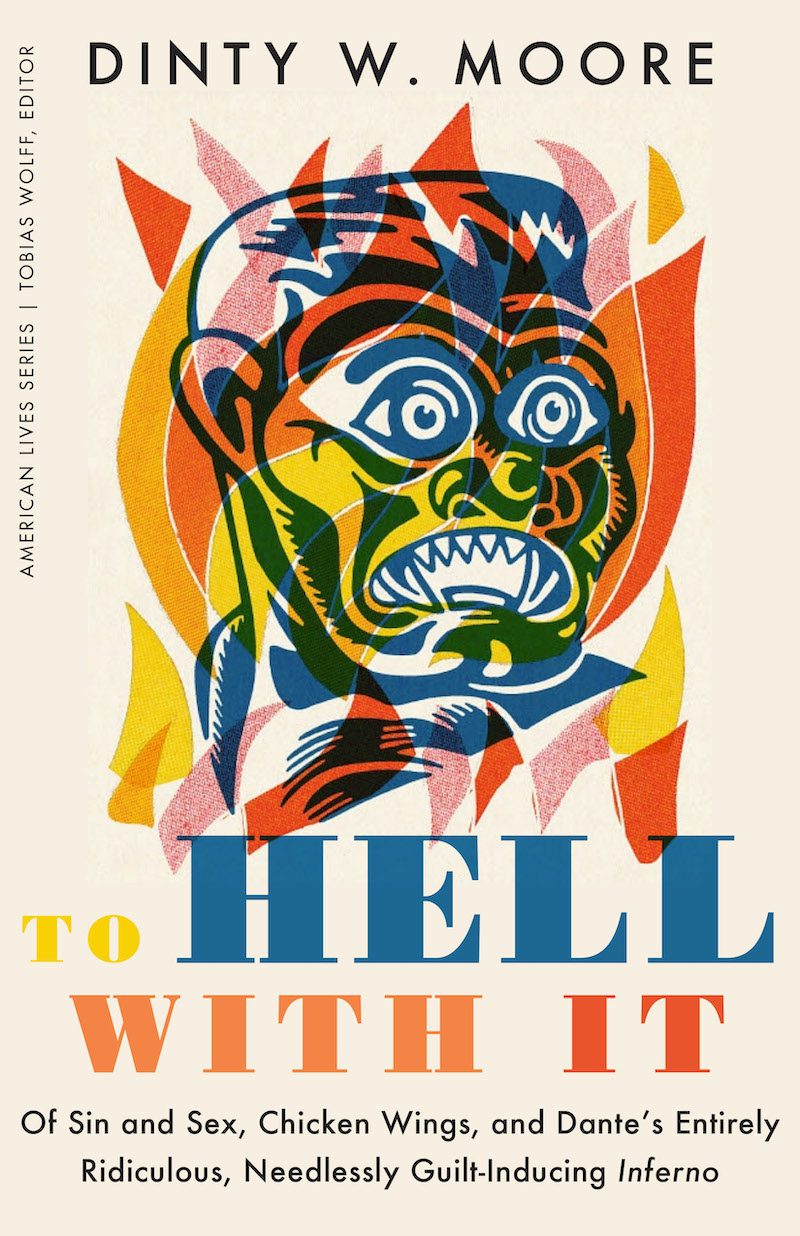I first met Dinty W. Moore at the River Teeth Nonfiction Conference back in 2016. I’d been an avid reader of Brevity for some time, and so by the time I was face-to-face with the man (whom I thought of as The Editor-in-Chief, all caps) I was a sprawling mess who tried to make a self-deprecating joke about New Coke and ended up saying something dumb like, Oh yes, I used to do cocaine. Fortunately for me, Moore’s sense of humor and grace extends beyond the page.
Moore has authored several books, including Between Panic and Desire, Crafting the Personal Essay, The Accidental Buddhist, and Dear Mr. Essay Writer Guy, and his writing has also been widely anthologized. He is the editor-in-chief of Brevity, which is now in its second decade of publication, and has a very nice garden. Moore’s forthcoming essay collection, To Hell with It: Of Sin and Sex, Chicken Wings, and Dante’s Entirely Ridiculous, Needlessly Guilt-Inducing Inferno, comes out on March 1 from University of Nebraska Press. To Hell with It moves between being tongue-in-cheek and deeply sincere as we travel through the narrator’s personal hells. The collection is structured around Dante’s Inferno, and each essay takes a slightly different shape, weaving together research and personal narrative and interspersed with images. It is an absolute delight (a reader’s Paradiso).
I had the good fortune to talk to Moore about two of his recent projects: The Best of Brevity: Twenty Groundbreaking Years of Flash Nonfiction, an anthology which was published by Rose Metal Press in November 2020 and co-edited with Zoë Bossiere, and his upcoming monograph. We covered everything from advice to our younger selves that we would’ve probably ignored to mental health to research in nonfiction writing.
***
The Rumpus: Twenty years of Brevity! That is older than some of my current students. Running any literary magazine is a labor of love; what has kept you motivated over the years, particularly in the beginning when you read all of the submissions yourself?
Dinty W. Moore: We are into our twenty-second year, in fact, which boggles my mind. The quality of the work that writers send to us is what keeps me motivated, and that was true in the early years as well. I remember receiving ten submissions one month and thinking, This is really great stuff; people are paying attention. Now we average three to four hundred submissions some months, and the quality of the writing, the innovation, the breathtaking honesty from the writers, just increases with time. I feel privileged to read the work.
Rumpus: How has Brevity evolved over the past two decades? Were there any particular moments that felt like “baby’s first sentence”?
Moore: The downside of receiving upwards of nine hundred submissions per issue is that you have to reject so many writers, and no, despite what some may think, we don’t enjoy that at all. With the quality of the submissions being so high, we find ourselves rejecting fairly good work, pieces that are maybe ninety-five percent of the way there but still aren’t perfect. The upside, of course, is that the work we eventually do publish is stunningly good. That’s the evolution that matters, of course.
Rumpus: Can you say a little bit about your role as an editor—for example, if you had to write an “editor’s statement.” How do you see an editor ideally functioning both in terms of individual pieces as well as curating an entire issue (or, twenty years of issues)?
Moore: Aside from helping to choose which pieces move from the “maybe” pile to “accepted” status, an important part of my role is institutional memory, knowing (more or less) what we have published over the years, trying to keep a balance of voices, styles, and subjects. Like so many others in the literary community, we have been more proactive these past few years about monitoring the diversity of each issue. The deliberate search for new voices, marginalized perspectives, writers outside of mainstream MFA culture, has made the magazine stronger, I think. It has certainly opened my mind in good ways.
Rumpus: Relatedly, how does that process compare to selecting essays for an anthology? Is it like curating an issue, but multiplied by X number of pages?
Moore: Selecting essays for the Best of Brevity anthology was both exciting and heartbreaking. The exciting part was rediscovering favorite pieces from five, ten, fifteen years ago, and the knowledge that they would now have new lives, find new readers. The heartbreaking part was the limitation of the printed page, the hard choices of what to include and what didn’t make the final cut. But that’s an editor’s job, and if I were paid for this work, that’s what they would pay me for.
Rumpus: If you could build a time machine and whisper some words of wisdom to your younger self when starting up the magazine, what would you say?
Moore: “Hey, Dinty, this magazine is going to be around for decades, so maybe figure out an income stream? Also, keep some records?” But I doubt I would have listened to myself.
Rumpus: How does your work as an editor impact your work as a writer?
Moore: Unfortunately, it takes a lot of my time, and that has an impact, but the plus side is how much I have learned about how sentences flow, how scenes are constructed, how images can do so much work, the beauty of metaphor in flash prose. You learn a lot from reading the work of others with an editor’s cap on your head, both what you might want to try for yourself and what to avoid. And of course, when you reject someone’s work for some weakness or other, you have to be just as strict with yourself.
Rumpus: Can you elaborate on that specifically when it comes to your latest collection, To Hell with It: Of Sin and Sex, Chicken Wings, and Dante’s Entirely Ridiculous, Needlessly Guilt-Inducing Inferno? Where was the editor’s cap particularly useful?
Moore: Perhaps the deepest impact of being an editor who has read so many essays—those that are not quite there, those that three-quarters of the way there, those that hit the mark squarely—is that I’m acutely aware of where my attention begins to flag. Over the years, I’ve learned to be just as tough on my own precious words, and in To Hell with It, for instance, there are four chapters that never made it into the book, despite my having worked off and on revising them for over a year. I am one of those writers who will write six pages to save three, tinker with those three pages repeatedly, and usually end up with one page if I’m lucky. I waste a lot of time and ink writing overly detailed explanations only to realize later in the editing process that I can say it more clearly in just a few words. Like this: “When self-editing, cross out the boring parts.”
Rumpus: As someone who was overly enthusiastic about the Inferno in high school, I’m interested in your process for structuring this book. At what point did you decide to use Dante’s cantos as an organizational principle? Put another way, which came first in the writing: the Catholic guilt or the Inferno?
Moore: The initial impulse for this book was depression, the sense of self-loathing that lingered well into adulthood, even though by many measures I’ve had a successful, fortunate life. I understand there are chemical explanations for our depressive tendencies, but I couldn’t shake the idea that Christian/Catholic teachings from my early childhood—essentially the idea that human beings are bad, rotten at our core, and for that reason Jesus had to die a horrible death—had infiltrated my consciousness deeper than I’d realized or ever wanted.
My response, of course, because I am weird that way, was to write a funny book. It took me many false starts, but once I landed on using Dante’s circles of Hell as my structure, the project took on a life of its own. I make fun of Dante’s many excesses throughout my book, but his poem is an amazing undertaking.
Rumpus: If I had to pick a favorite illustration in this—and there are several contenders—it would probably be the “homosexual steamroller.” Can you talk a little bit about the tools you used to make them—particularly the ones that are a photo/drawing mashups?
Moore: I’m afraid my drawing and photo-editing tools are not so very sophisticated. I drew the pictures by hand, on scraps of old printer paper; used a photocopier to turn them into digital files; and then employed an off-brand (I’m either frugal or cheap) photo editor to add a little shading, or to cut and paste family photos into the mix. The freehand drawing aspect was most interesting to me, because the pictures I created in many ways resemble the little doodles I would scribble all throughout grade school—I was a good student, and thus bored much of the time—and reverting to the doodles helped me transport back to the mind-space of that weary, skeptical little boy in religion class.
Rumpus: I keep thinking about the chicken-eating contest. How many of the events in this collection did you go into with this project in mind?
Moore: The book is a hybrid of memoir, reportage, essaying, theological speculation, and, as you so generously mentioned, peculiar illustrations. I decided to explore gluttony firsthand, which ultimately led me to the chicken-wing-eating contest in Colonel Sanders’s hometown, and I likewise sought out The World’s Largest Yard Sale to explore greed and avarice.
A few years back I attended the American Atheists’ convention in downtown Memphis, held on Easter weekend, which was jolly fun but didn’t ultimately make it into the book. I heartily endorse the idea that nonfiction writers, even those who identify as memoirists, shake things up and thrust themselves into unusual situations. Life is odd, and our oddities are so endlessly interesting.
Rumpus: I was struck by the tone toward the end of the collection, especially in “Bring on the Ass Trumpets.” There’s something about the absence of the narrator and the pulled-back nature of the footnote structure that makes the essay feel more critical than an invective. I imagine there’s an abundance of material to choose from—what made you focus on The Boy Who Came Back from Heaven?
Moore: The story behind The Boy Who Came Back from Heaven is tragic on so many levels, but the one detail, that the family name was, of all things, “Malarkey,” raised the tragedy to some absurdist level, like a bad Ionesco play, or Beckett on acid. Add in the rather clumsy “visions” the father apparently invented for his poor son, and the whole, sad affair borders on farce. Invective was unnecessary since the facts speak so bleakly for themselves, but you are right about the tone change. I wanted the book to be an enjoyable, comic tour of the mythology of Hell, but real damage is done by fraudulent religious claims, and lives are destroyed by the burdens of guilt and blame. So, I went there.
Rumpus: Again and again, this collection circles (forgive me) back to issues of dejection and self-loathing—how these feelings are often fueled by the notion that we are failing and should be better. If humor and incredulity are what this narrator finds upon exiting his own inferno, what do you hope that readers will take away from this collection?
Moore: My hope is that readers might seriously question, even if they have rejected some or all the religious instruction they were given early on, how much of what they were taught still managed to seep into their psyche, and the damage those manipulative teachings might do to our capacity for happiness. Hell is not a real place, but how often do we silently think to ourselves, Oh, I’m definitely going to Hell for that? We have so many negative voices, and I think many of them were planted in our earliest days. Examine them—and throw them out if you can.
Rumpus: What are some of the books you read as part of your writing process for To Hell with It? Not just the source texts, like Confessions and The New St. Joseph Baltimore Catechism, but also those texts whose hearts hold tiny seeds that helped yours flourish?
Moore: Vonnegut was a clear influence, in terms of tone and style. I read dozens of books about original sin, about the origins of Hell as a spiritual concept, about Adam and Eve, and on the life of Dante. The work of the religious historian Elaine Pagels was highly useful, as was, oddly enough, Pema Chodron’s When Things Fall Apart.
Rumpus: I know we’ve all spent the past year inside, but what are your plans for the future? Any projects in the works? A virtual book tour?
Moore: I had hoped to be showing up in front of bookstores with a folding table and offering indulgences and taking confessions when the book launched this spring, but like everyone else I am busily trying to figure out how to get the word out about the book while everyone is stuck at home. Ironically, given my anti-religious stance in the book, I may resort to prayer.
***
Photograph of Dinty W. Moore by Renita M. Romasco.






